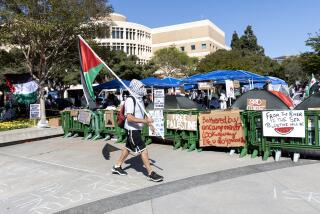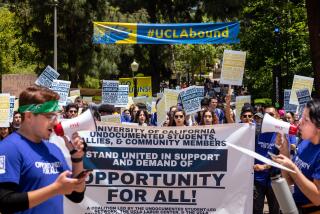Poster Designers Draw on Experience as ‘New Californians’
It was a passionate, hard-sell pitch, printed in Spanish on the white bars of an American flag.
In translation, it read:
“My Hispanic friend, better yourself, study . . .
“Study so you will know your rights and obligations.
“Study and demonstrate that Hispanics can triumph too . . .
“Learn, and you will not be exploited.”
The words were those of Natalia Rodriguez, a middle-aged woman in a black-and-white print dress whose English failed her when the moment came to receive her award.
So she spoke to the man in the sleek blue suit who had introduced her, and he repeated her short acceptance speech in English.
“Her message is to all students that they continue their education,” said Jose Quintanar, amnesty program director at Glendale College. “That is the only path to success.”
Rodriguez was one of four students at the school to win awards in a statewide poster design contest promoting the community college amnesty programs. The assignment was to produce a graphic design and message encouraging those who had obtained permanent residency through the U.S. Immigration Reform and Control Act of 1986--the amnesty law--to stay in school.
The winners were recognized Tuesday afternoon in a modest outdoor ceremony at the college’s San Rafael Plaza. Richard Stiles, manager for the Amnesty Education Office of the state Department of Education, flew down from Sacramento to say a few words.
The contest itself was modestly conceived. Its purpose was to give a pat on the back to the amnesty students and come up with some student-originated advertising copy for the last and most ambitious phase of the federal amnesty program.
That is continued education and, finally, citizenship for the 1.7 million “New Californians,” as the educational community has called the state’s once-illegal residents allowed by the act to gain legal residency by completing 40 hours of classroom study of English, history and civics.
All but a fraction of those drawn out of the shadow economy by the offer have completed their class requirements and gotten green cards. For them, the next step is to become citizens.
And the 14 community colleges, including Glendale, that developed amnesty programs are now finding recruitment essential to keeping their amnesty students in school for those five years on the road to citizenship.
For many of the new residents, that’s a lot to ask.
According to a group called Community College Educators of New Californians, the Immigration and Naturalization Service reports that 98% of the new residents are Latino and 65% have not mastered the basic skills taught in the first 6 1/2 years of public education.
To qualify for amnesty, they have only to show “satisfactory progress” in school. Goals can be tailored for those who are illiterate in their native tongue, unable even to write their names. “If they learned to write their name, that was accepted,” Quintanar said.
Schools such as Glendale College have considerable stake in getting students back for more classes. If they don’t, the amnesty programs will simply dry up, along with the federal support they bring to the institution.
Glendale College graduated 4,500 with the initial 40 hours of instruction. It now has 700 students enrolled in the school program. Some take only English as a second language classes. Others take a special bilingual math class. Most, though, are in at least some of the college’s general education classes.
Quintanar said the amnesty program has even used phone banks to follow up on the mailing of class schedules.
“It proves to be very effective, that personal touch,” Quintanar said.
The poster contest was another kind of personal touch, to get the message out in words and images created by successful students.
One hundred students sent in entries in the form of rough, freehand drawings. Fellow students judged the work, selecting 11 semifinalists and five finalists, four of the total from Glendale College. The winning entries went to a professional design studio to be rendered into high-quality posters. They will now be printed on literature produced by the state office.
Along with its use in recruitment, this literature will figure in the lobbying for continued financial support for amnesty programs.
Much of Tuesday’s ceremony, in fact, turned into a plea for understanding of the amnesty students and the necessity of their education.
Stiles said the work force of the future is at stake.
“We will have a more competitive work force to deliver more goods to the states and the country as a whole,” he said.
Quintanar concluded with a more personal reflection on New Californians such as Marta Interiano, another middle-aged woman who stood beside him to receive her award.
“Probably very few people have an idea what kind of people they are,” he said. “Their roots are very deep. . . . When you see these people on campus, say hello to them. They’re part of the whole family.”
Interiano also found her English lacking for the occasion. But her flair for slogans came across nicely.
“Education is the nectar and the complement of being human,” her poster said.
More to Read
Sign up for Essential California
The most important California stories and recommendations in your inbox every morning.
You may occasionally receive promotional content from the Los Angeles Times.











